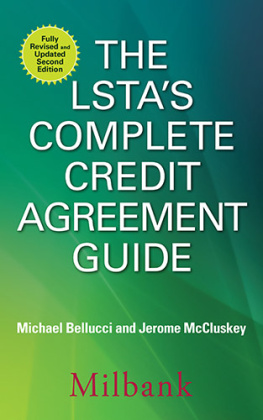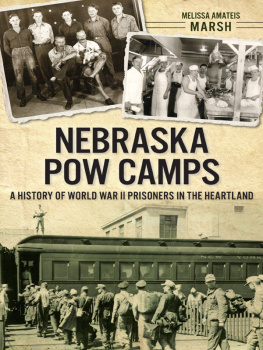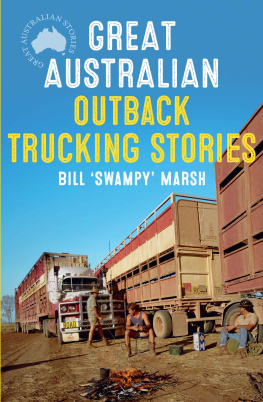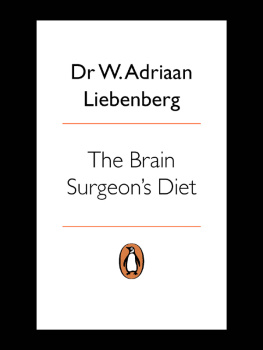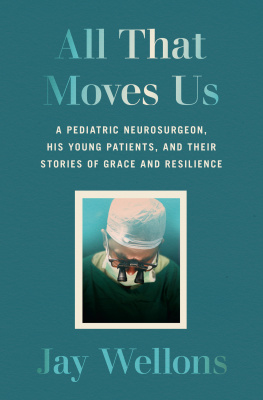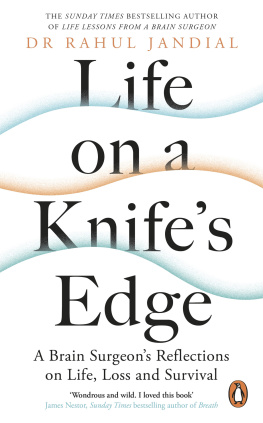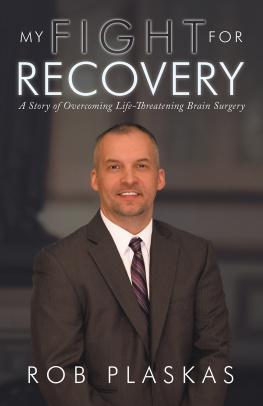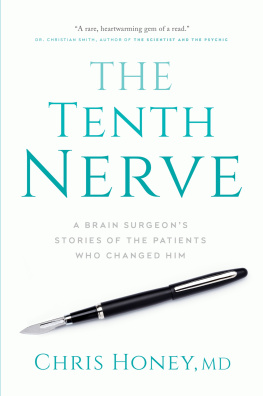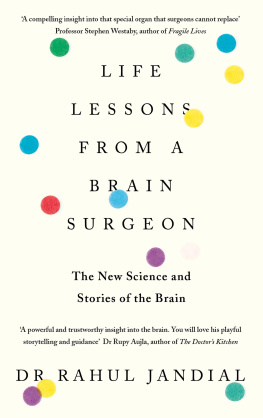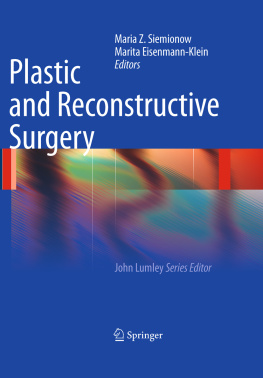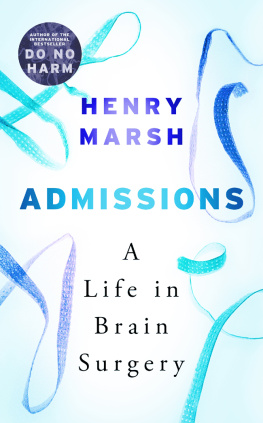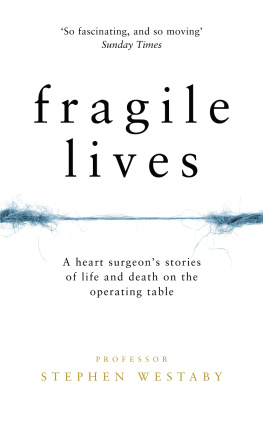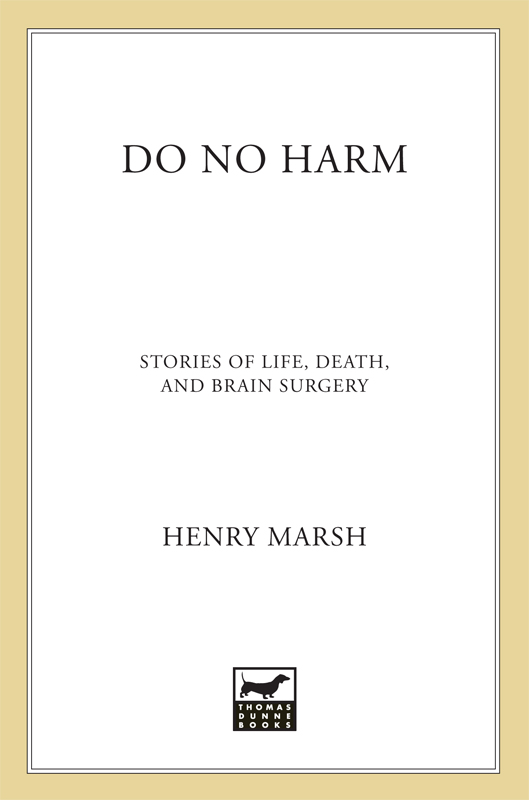Contents
Guide

The author and publisher have provided this e-book to you for your personal use only. You may not make this e-book publicly available in any way. Copyright infringement is against the law. If you believe the copy of this e-book you are reading infringes on the authors copyright, please notify the publisher at: us.macmillanusa.com/piracy.
Contents
For Kate, without whom this book would never have been written
First, do no harm
Commonly attributed to Hippokrates of Kos, c. 460 BC
Every surgeon carries within himself a small cemetery, where from time to time he goes to pray a place of bitterness and regret, where he must look for an explanation for his failures.
Ren Leriche, La philosophie de la chirurgie, 1951
Throughout my career I have been fortunate to work with colleagues from Americamainly neurosurgical residents who come to work for one year in my department in London as part of their training. I have learned much from them and as with many Brits who have worked with Americans I love their optimism, their faith that any problem can be solved if enough hard work and money is thrown at it, and the way in which success is admired and respected and not a cause for jealousy. This is a refreshing contrast to the weary and knowing skepticism of the English. Yet when I visit American hospitals and see the extremes to which treatment can sometimes be pushed, I wonder whether the doctors and patients there have yet to understand that the famous dictum that in America death is optional, was meant as a joke.
I have also worked in countries such as Ukraine and Sudan that have very impoverished health care systems compared to America. You realize quite quickly, however, that despite the very great differences in equipment and technology many things are the same. Our vulnerability and fear of death when we are patients know no national boundaries, and the need for honesty and kindness from doctorsand the difficulty at times in giving theseis equally universal. I would hope that my many American trainees have come to understand this by working in the foreign country that is England, just as I have done with my work abroad.
Doctors will sometimes admit their mistakes and complications to each other but are reluctant to do so in public, especially in countries that have commercial, competitive healthcare systems. This book is as much about failure as success, but it is not intended as a confession and instead is an attempt to give an honest account of what it is like to be a neurosurgeon. My readiness to admit to my fallibility is perhaps rather English, but I hope that the problems I describe will be familiar to doctors and patients everywhere. The book is also the story of an all-encompassing love affair, and an explanation of why it is such a privilegealthough a very painful oneto be a neurosurgeon.
Henry Marsh, August 2014
n. an uncommon, slow-growing tumour of the pineal gland.
I often have to cut into the brain and it is something I hate doing. With a pair of diathermy forceps I coagulate the beautiful and intricate red blood vessels that lie on the brains shining surface. I cut into it with a small scalpel and make a hole through which I push with a fine sucker as the brain has the consistency of jelly a sucker is the brain surgeons principal tool. I look down my operating microscope, feeling my way downwards through the soft white substance of the brain, searching for the tumour. The idea that my sucker is moving through thought itself, through emotion and reason, that memories, dreams and reflections should consist of jelly, is simply too strange to understand. All I can see in front of me is matter. Yet I know that if I stray into the wrong area, into what neurosurgeons call eloquent brain, I will be faced by a damaged and disabled patient when I go round to the Recovery Ward after the operation to see what I have achieved.
Brain surgery is dangerous, and modern technology has only reduced the risk to a certain extent. I can use a form of GPS for brain surgery called Computer Navigation where, like satellites orbiting the Earth, infra-red cameras face the patients head. The cameras can see the instruments in my hands which have little reflecting balls attached to them. A computer connected to the cameras then shows me the position of my instruments in my patients brain on a scan done shortly before the operation. I can operate with the patient awake under local anaesthetic so that I can identify the eloquent areas of the brain by stimulating the brain with an electrode. The patient is given simple tasks to perform by my anaesthetist so that we can see if I am causing any damage as the operation proceeds. If I am operating on the spinal cord which is even more vulnerable than the brain I can use a method of electrical stimulation known as evoked potentials to warn me if I am about to cause paralysis.
Despite all this technology neurosurgery is still dangerous, skill and experience are still required as my instruments sink into the brain or spinal cord, and I must know when to stop. Often it is better to leave the patients disease to run its natural course and not to operate at all. And then there is luck, both good luck and bad luck, and as I become more and more experienced it seems that luck becomes ever more important.
* * *
I had a patient to operate on with a tumour of the pineal gland. In the seventeenth century the dualist philosopher Descartes, who argued that mind and brain are entirely separate entities, placed the human soul in the pineal gland. It was here, he said, that the material brain in some magical and mysterious way communicates with the mind and with the immaterial soul. I dont know what he would have said if he could have seen my patients looking at their own brains on a video monitor, as some of them do when I operate under local anaesthetic.
Pineal tumours are very rare. They can be benign and they can be malignant. The benign ones do not necessarily need treatment. The malignant ones can be treated with radiotherapy and chemotherapy but can still prove fatal. In the past they were considered to be inoperable but with modern, microscopic neurosurgery this is no longer the case. It is usually now thought necessary to operate at least to obtain a biopsy and confirm the type of tumour so that you can decide how best to treat the patient. The pineal is buried deep in the middle of the brain so the operation is, as surgeons say, a challenge. Neurosurgeons look at brain scans showing pineal tumours with both fear and excitement, like mountaineers looking up at a great peak that they hope to climb.
This particular patient had found it very hard to accept that he had a life-threatening illness and that his life was now out of his control. He was a high-powered company director. He had thought that the headaches which had started to wake him at night were caused by the stress of having had to sack so many of his employees in the aftermath of the financial crash of 2008. It turned out that he had a pineal tumour and acute hydrocephalus. The tumour was obstructing the normal circulation of cerebro-spinal fluid around his brain and the trapped fluid was increasing the pressure in his head. Without treatment he would go blind and die within a matter of weeks.
I had had many anxious conversations with him over the days before the operation. I explained that the risks of surgery, which included death or a major stroke, were ultimately less than the risks of not operating. He laboriously typed everything I said into his smartphone, as though typing down the long words obstructive hydrocephalus, endoscopic ventriculostomy, pineocytoma, pineoblastoma would somehow put him back in charge and save him. His anxiety, combined with my feeling of profound failure about an operation I had carried out a week earlier, meant that I faced the prospect of operating upon him with dread.




